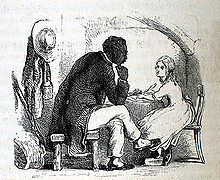Uncle Tom Syndrome

The psychological term Uncle Tom Syndrome describes ritualized, adapted and submissive behavior of African Americans towards whites . The person affected by this syndrome shows such docile and docile behavior that he is not perceived as a threat by the white counterpart.
Concept emergence
The term goes back to the novel Uncle Toms Hütte by Harriet Beecher Stowe published in 1852 . The book was a tremendous hit and the intent was to educate the American public about the evil of slavery . To this day, however, the work has caused controversy: The novel tells how the slave Uncle Tom is brutally beaten by the slave owner Simon Legree and, despite this cruelty, retains dignity and pride. Contemporary readers in particular often find this portrayal condescending and insulting.
Uncle Tom Syndrome was originally a survival strategy used by American slaves. Whenever they were perceived as a threat or challenge by the slave owner, they risked their physical integrity and their lives. In addition to the coping strategy of “Playing it cool” (German: “To play the uninvolved”), the African-Americans thus developed a ritualized social role in their interaction with the slave owner, which was characterized by sociability, appeasement and submissive behavior.
Uncle Tom
Since the appearance of Uncle Tom's Cabin , the term "Uncle Tom" has acquired a specific cultural meaning for a person with this behavior that extends beyond the original context of Stowe's novel. It has developed an insulting connotation and is applied to Afro-Americans who persist in passivity and willingly try to appease whites. Malcolm X, for example, regularly referred to Martin Luther King as “Uncle Tom” because he was limited to peaceful protests against racial segregation . The legal scholar Brando Simeo Starkey sees in the term not only the character of a derogatory remark about alleged traitors of the Afro-American community, but also a system of social norms that is supposed to strengthen cohesion among blacks.
Todays situation
Both coping strategies have survived to this day, as political and economic power still largely rests with white Americans. According to Paul E. Priester, due to repressive social conditions in the United States, it is still necessary for African Americans to resort to the survival strategies of “Playing it cool” and Uncle Tom Syndrome. This is the case, for example, when they have to face a white teacher, supervisor or judge. The two styles of interaction are particularly important for African American men, as black women are perceived as less of a threat by many whites. More recently, the term has also been used outside the racial context of the United States to refer to the relationships between conquered cultures and their colonial masters.
literature
- Brando Simeo Starkey: In Defense of Uncle Tom: Why Blacks Must Police Racial Loyalty. Cambridge University, New York 2015, ISBN 978-1-107-07004-2 .
- Paul E. Priest: Uncle Tom Syndrome. In: Yo Jackson (Ed.): Encyclopedia of Multicultural Psychology . Sage, Thousand Oaks 2006, ISBN 1-4129-0948-1 , p. 461 f.
Remarks
- ^ Paul E. Priest: Uncle Tom Syndrome. In: Yo Jackson (Ed.): Encyclopedia of Multicultural Psychology . P. 461 .
- ^ Paul E. Priest: Uncle Tom Syndrome. In: Yo Jackson (Ed.): Encyclopedia of Multicultural Psychology . P. 461 .
- ↑ Brando Simeo Starkey: In Defense of Uncle Tom: Why Blacks Must Police Racial Loyalty. P. 196 .
- ↑ Brando Simeo Starkey: In Defense of Uncle Tom: Why Blacks Must Police Racial Loyalty. P. 2 f.
- ^ Paul E. Priest: Uncle Tom Syndrome. In: Yo Jackson (Ed.): Encyclopedia of Multicultural Psychology . P. 461 f.